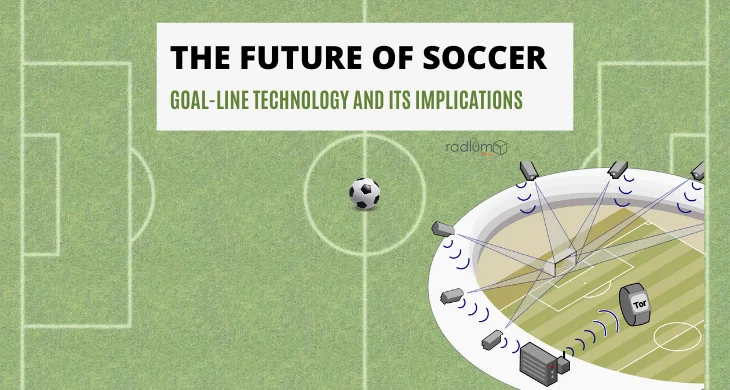In the fast-paced world of modern football, the introduction of goal-line technology has sparked widespread debate and revolutionized the way matches are officiated. Gone are the days of contentious goal-line decisions and disputed outcomes. With the implementation of sophisticated technological solutions, the beautiful game has entered a new era of fairness and accuracy.
Evolution of Goal-Line Technology
In football, there have been many times when it’s been hard to tell if the ball actually went into the goal. Remember that moment with Frank Lampard’s shot during the 2010 World Cup? It was a big deal because everyone could see it went in, but the referee didn’t. That’s just one example of how controversial decisions can affect the game. These incidents made people realize we needed a better way to know if a goal happened or not. That’s where goal-line technology comes in. It uses special cameras and sensors to track the ball and instantly tells the referee if it crossed the goal line. It’s like having an extra set of eyes to make sure we get the right calls and avoid those frustrating moments when the whole world can see a goal, but the officials miss it.
Introduction of goal-line technology
To solve these problems, people came up with different ways to use technology to check if the ball crossed the goal line. Finally, in 2012, the International Football Association Board (IFAB) said it was okay to use this technology in matches. It was a big deal because it meant we could finally have a more accurate way to tell if a goal happened. Imagine the relief for players, fans, and referees knowing there’s a reliable system in place to avoid those controversial moments. It’s like having a safety net to make sure the right calls are made and the game is fair for everyone. This decision changed the game for the better and showed that sometimes, technology can help us enjoy sports even more.
How does goal-line technology work?
Goal-line technology works like this: there are special cameras placed around the stadium that watch the ball closely. When the ball gets close to the goal line, these cameras track its position. If the ball crosses the line, sensors detect it immediately and send a message to the referee’s watch. This way, the referee knows for sure if a goal happened or not, even if it’s hard to see from where they’re standing. It’s like having extra eyes on the field to catch those tricky moments. This technology takes the pressure off the referees and helps them make the right call every time. So, when there’s a close call, everyone can trust that the decision is fair and accurate. It’s a game-changer that adds more excitement and certainty to the beautiful game of football.
Types of goal-line technology
There are several types of goal-line technology, but the most commonly used systems involve the use of cameras and sensors installed around the goal area. These devices track the movement of the ball and provide real-time data to match officials.
- VAR (Video Assistant Referee) system
Apart from goal-line technology, leagues also use Video Assistant Referee (VAR). It’s like having a backup referee watching the game on video. When there’s a big call, like a goal or a penalty, the main ref can ask VAR for help. VAR checks the video replays to see if the ref missed anything important. This helps referees make fairer decisions and avoid big mistakes that could change the game’s outcome. So, if there’s a doubt about a goal or a foul, the ref can double-check with VAR to get it right. It’s a bit like having a second pair of eyes to make sure the game stays fair and everyone plays by the rules. While some people debate its effectiveness, VAR adds another layer of fairness and accuracy to football matches, making them more transparent and trustworthy.
- Fairness and accuracy
Goal-line technology is a game-changer in football because it makes decisions fairer and more accurate. Imagine a close call during a match—did the ball cross the line for a goal or not? With this technology, there’s no guessing. High-speed cameras track the ball, and if it crosses the line, sensors instantly tell the referee. It’s like having a referee with superpowers—they can’t miss a thing! This helps avoid arguments and keeps the game flowing smoothly. Plus, it takes the pressure off referees, so they can focus on other important calls. So, whether it’s a last-minute winner or a crucial equalizer, goal-line technology ensures that every goal is counted correctly, leaving no room for doubt or controversy. It’s all about making football fairer and more exciting for players and fans alike.
- Reduction of referee errors
Goal-line technology is like having an extra set of eyes on the field, easing the burden on referees. Imagine being in their shoes; the game is fast-paced, and every decision counts. With this technology, they get a helping hand. No more guessing if the ball crossed the line or not. The system instantly tells them, so they can focus on other important calls. This takes the pressure off referees and helps them make fairer decisions. Plus, it gives players and fans more confidence in the game. No more debates over whether a goal should count or not – the tech has it covered. It’s all about making football more enjoyable and ensuring that everyone can trust the outcome, no matter how intense the match gets.
Adoption in major football leagues
FIFA’s stance
FIFA, which oversees football globally, is all for goal-line technology. They want it everywhere! Why? Because it keeps the game fair and trustworthy. FIFA believes these systems are like referees’ best friends, helping them make the right calls without any doubts. And hey, they’re not alone in this. Many football associations around the world agree. They see goal-line technology as a game-changer, making sure that goals are counted when they should be and not when they shouldn’t. It’s like having a referee’s assistant who never gets it wrong. So, when FIFA says, “Let’s use this tech,” everyone listens. After all, who doesn’t want football matches decided by what actually happens on the field, not by guesswork or human error?
Implementation in top leagues
Goal-line technology isn’t just for big leagues; it’s everywhere! The English Premier League, La Liga, and the Bundesliga all use it. And guess what? It’s a hit! Fans, players, and coaches love it because it takes out the guesswork. Whether it’s a goal or not, the tech settles it once and for all. And it’s not just for the pros. Even local leagues are getting in on the action. Why? Because when something works so well, everyone wants a piece of it. So, if you’re playing football on a Sunday morning or watching your favorite team on TV, chances are, goal-line tech is making sure the right decisions are made. It’s like having a super-accurate referee who never misses a thing!
Challenges and criticisms
Cost implications
While goal-line technology is great for accuracy, it comes with a hefty price tag. For smaller clubs and leagues, shelling out cash for these systems isn’t easy. They’ve got budgets to stick to, and fancy tech might not make the cut. It’s like wanting a top-of-the-line smartphone but having a flip phone budget. Sure, it’d be nice to have all the bells and whistles, but sometimes you have to work with what you’ve got. So, while big leagues can splash the cash, smaller clubs might have to stick to good old-fashioned ref calls. It’s not ideal, but hey, football’s all about playing fair, no matter what technology’s on the field.
Impact on game flow
Critics say technology’s like that annoying friend who always interrupts a good chat. When the game’s flowing nicely, and suddenly, there’s a stoppage for a video review, it’s like hitting pause on your favorite show right in the middle of a cliffhanger. Players get antsy, fans start grumbling, and the vibe changes from excitement to annoyance. It’s kind of like when your Wi-Fi cuts out during a binge-watch session—total buzzkill. They argue that football’s beauty lies in its raw, unpredictable nature, and tech takes away from that. But hey, others reckon it’s just part of the game’s evolution. Like switching from black-and-white TV to high-definition—yeah, it’s different, but maybe it’s for the better in the long run. Either way, there’s no denying that it sparks some heated debates on and off the pitch.
Future advancements
Integration with other technologies
Imagine if goal-line tech had a brain of its own, like your phone’s voice assistant but for football. With AI and AR joining the game, it’s like upgrading from a basic flip phone to the latest smartphone—things get smarter, faster, and way cooler. Picture this: instead of just spotting when the ball crosses the line, tech could predict player movements, flag offside calls, and even analyze fouls in real-time. It’s like having a supercharged referee who never misses a beat. And with AR, fans at home or in the stadium could get instant replays from every angle, making sure they never miss a crucial moment. It’s like being right there on the pitch, but without the risk of getting tackled! Sure, it’s still in the works, but hey, the future of football could be as futuristic as a sci-fi movie, and that’s pretty exciting!
Potential for AI enhancements
Imagine if goal-line technology could think for itself, like your phone predicting your next word. With AI, it’s like upgrading from a basic calculator to a supercomputer—it gets smarter, faster, and way more accurate. Picture this: instead of just spotting when the ball crosses the line, AI could analyze player movements, predict passes, and even anticipate fouls in real-time. It’s like having a super-ref who never misses a trick. And the best part? As AI learns from every game, it keeps getting better and better, making those crucial calls with pinpoint precision. Sure, it’s still early days, but with AI on the field, the future of football could be as thrilling as a championship final – and that’s something to cheer about!
Conclusion
In conclusion, goal-line technology represents a significant advancement in the world of soccer, with far-reaching implications for the sport. By ensuring fairness, accuracy, and transparency in decision-making, these systems contribute to a more level playing field and enhance the overall fan experience. While challenges remain, the future of soccer looks brighter than ever, thanks to the continued evolution of technology.
FAQs
Que: How accurate is goal-line technology?
Ans: Goal-line technology is incredibly accurate, with most systems boasting a margin of error of less than one centimeter.
Que: Does goal-line technology slow down the game?
Ans: While there may be brief stoppages for video reviews, the overall impact on game flow is minimal compared to the benefits it provides in terms of fairness and accuracy.
Que: Are all football leagues required to use goal-line technology?
Ans: No, the use of goal-line technology is not mandatory for all leagues. However, many top-tier competitions have adopted these systems to ensure the integrity of their matches.
Que: What happens if goal-line technology fails during a game?
Ans: In the event of a technical malfunction, match officials will revert to traditional methods of determining goal-scoring opportunities, such as relying on the judgment of the referee and assistant referees.
Que: Is goal-line technology expensive to implement?
Ans: Yes, goal-line technology can be costly to install and maintain, which may present challenges for smaller clubs and leagues with limited financial resources.




